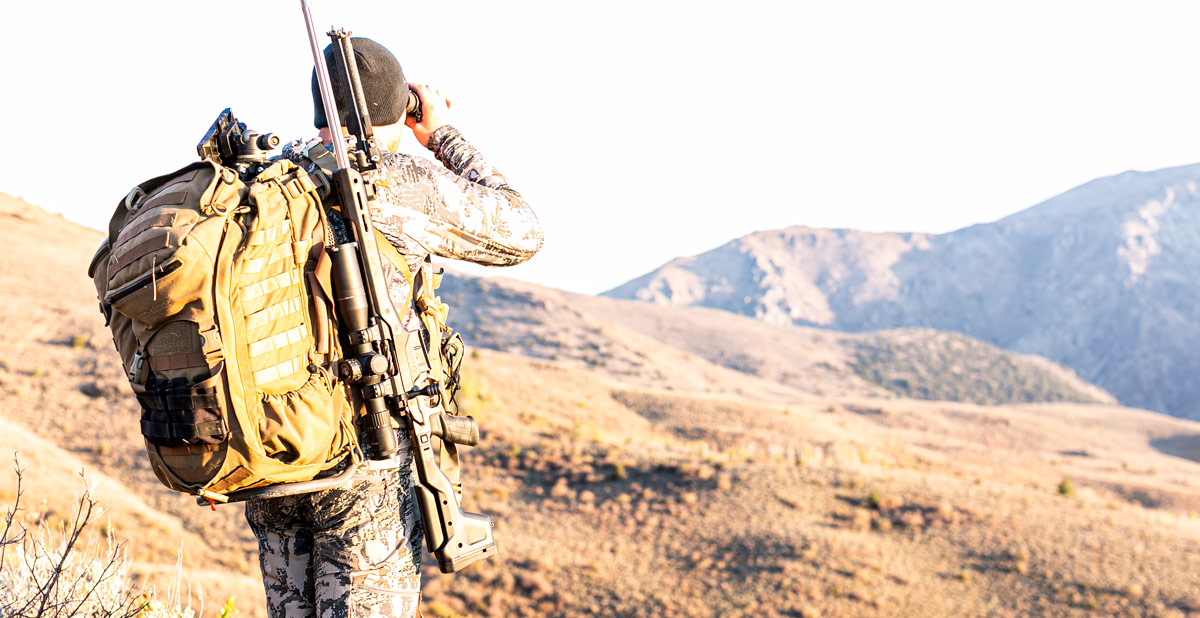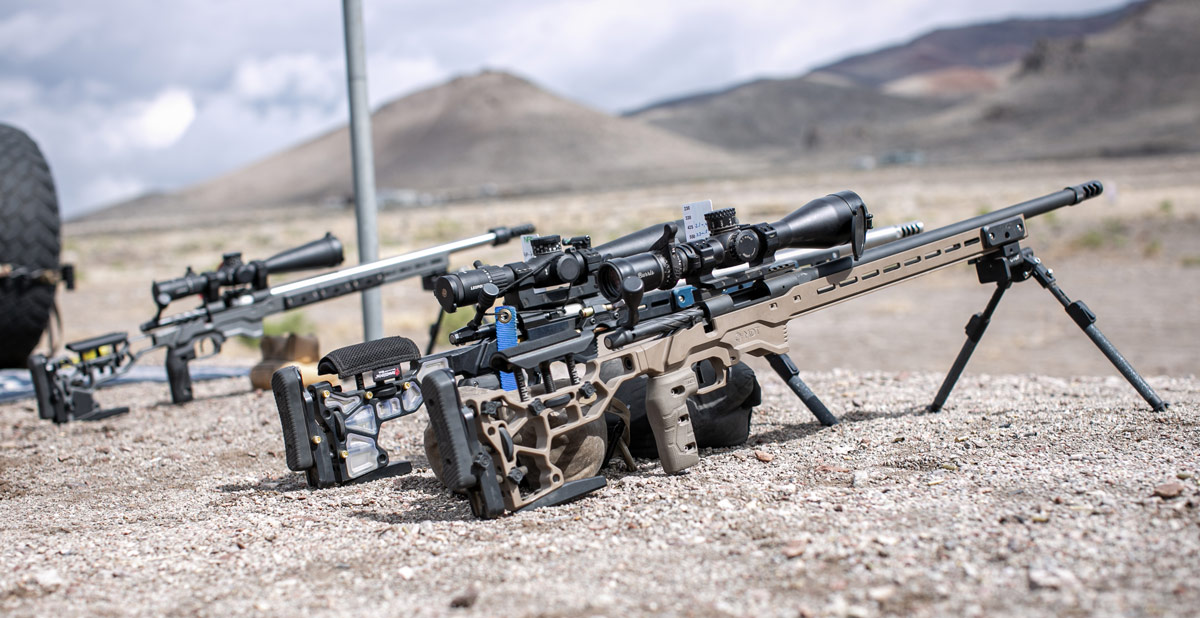Posted by Matt Hornback on 2022 Jul 12th
Expert Gear Guide for Precision Rifle Competition
Editors Note: This article was published on April 2nd, 2019. This is an updated version of the original article.
So you bought a rifle, optic, and ammunition. Unfortunately, you still need a few more things to succeed in Precision Rifle Competition. There are endless packs, shooting bags, weather/ballistics tools, tripods, etc. How can you possibly be competitive without all of this stuff?! Some of the latest doo-dads will make life easier on you during stages, but one thing that will pay dividends is the word "FUNDAMENTALS"! Without solid fundamentals, all the gear in the world won't do you any good. Remember, gear is meant to make tasks easier, not to do the work for you.
In my opinion, some things in precision rifle matches are mandatory (aside from safety items).
- Rifle and ammo capable of 1 MOA or better throughout an entire course of fire
- Bipod
- Small rear bag
- Sling
- Notebook and Pen
- DOPE and ballistics solver
My loadout comprises things that I routinely use to succeed at matches. I'm not particularly eager to carry any unnecessary items. When starting, keep everything as simple as possible. "Beware the man who only has one gun. He probably knows how to use it" This mantra should be applied to every item in your shooting kit. I can give you a lesson learned the hard way; the next hot piece of gear, caliber, or rifle will not put rounds on target unless you are well acquainted with it. Too often, I see shooters show up at matches with a new game-changing piece of gear. Switching calibers, rifles, and scopes can cause headaches during matches. There's something to be said for consistency: the word "impact."
LET'S TALK ABOUT ELECTRONICS
Technology is wonderful, but pen, paper, and memory don't need batteries. With that said, there are two items that I never leave home without, my Kestrel 5700AB and my load data and DOPE notebooks. I wish I relied on paper data more, but the truth is, the all-in-one wonder machine gives me all the data I could want in a matter of seconds. This data can be sourced in other ways, but there is a definite price for convenience.
One word about ballistics software, they are only as good as the data you provide them. Take a Kestrel class, or leverage the free resources available from Kestrel. If you are not doing the proper calibrations and inputting CORRECT data, you might as well be shooting blind. The rule to live by is "only confirmed data is good data." Spare batteries, ALWAYS!

Tripods and bags are great tools to have.
BACKUPS, WHAT TO BRING?
I have seen several shooters approach this in different ways, from the absurd to the non-existent. I recall one match where mid-stage, a shooter identified that he had a failed extractor claw on his custom action. In about 5 minutes, he had a new claw and spring swapped out with a small set of tools and parts he kept in his pack. I have even seen shooters bring entire bolt assemblies as spares, and even one situation where one shooter lent out a spare AI bolt to another shooter who left theirs at home. More often than not, maintenance leads to lost items, and when traveling, these small items can be tough to source. Carry a wider array of parts if shooting something not commonly found.
GEAR LISTS
Below are my one and two-day gear lists.
One day packing list:
- Pack
- Two mags
- Schmedium Gamechanger
- Milk Toast Flat Bag
- Arca plate
- Rifle cover (for rain and dust)
- Lens pen/cleaner
- Chamber brush
- Fix-it sticks
- Water-erase pens for dope cards
- Clipboard with COF
- Tripod
- Binos
- Rangefinder
My two-day packing list includes everything from my one-day list plus the following items:
- Spare trigger
- Small parts spares (action screws, bolt stop, firing pin, rails, rings, mounts, etc.)
- Allen wrench set
- Lighter fluid (for flushing out triggers)
- Oil
- Solvent
- Cleaning rod or bore snake
- Labradar (or magnetospeed)
- Wet weather top
- A third magazine
Plan for the worst-case scenario. What do you need to remedy case head separation quickly? Most of the time, this can be fixed with a cheap (or free) Glock 9mm nylon cleaning brush and handle. These come in all Glock firearms and have saved many shooters from that piece of brass reloaded one too many times.
WATERPROOFING, DOES IT MATTER?
I can't advise this enough, WATERPROOF EVERYTHING! Keep all items in ziplock bags and bring spares. Countless times I've had to shoot in inclement weather; the match must go on! Many people take the weather for granted and are ill-prepared for that freak rain shower that soaks all their gear. Keep a few grease pens and Rite In The Rain notebooks handy just in case you need to transcribe data during wet conditions.
TO CLEAN, OR NOT TO CLEAN?
Once my rifle is zeroed and has a few rounds down the barrel, I do not clean it during the span of a match. There are many differing opinions, but I prescribe to the old "if it ain't broke, don't fix it" mantra. With that said, I do pack a small cleaning kit for that worst-case scenario, including a stuck case.
- Collapsible cleaning rod
- Caliber-specific jag and brass bore brush
- Hoppe's #9 in a dropper bottle
- Synthetic gun oil (NOT grease)
- Bore patches (caliber appropriate)
- Nylon Toothbrush style brush
- Q-Tips, 20ct
- Multitool and bits
All of this fits in a small nylon pouch and goes neatly in my pack. I also stay away from bore snakes. I have seen these dirty contraptions do more harm than good and would advise against their use in your super-match-ultra-premium barrel you spent a rent check on.
EXTRA OPTICS, A NECESSITY?
Toting around binoculars and/or spotting scope can be cumbersome but are incredibly helpful for helping spot impacts for other shooters and seeing the conditions during a fire course. Optics are a no-brainer if you plan on utilizing a tripod for shooting positions. If not, I still recommend bringing a small set of binoculars. Range finders are incredibly useful for double-checking target ranges and are sometimes mandatory for field matches.
SHOOTING BAGS, WHICH ONES?
A small rear bag is necessary; all others are pure preference. If I could only take one bag to a match, it would be the Reasor Precision/Armageddon Gear Game Changer bag. This bag seems to have it all covered and has yet to let me down.
BAG IT ALL UP!
Selecting a pack is more complicated than it should be; keep it simple. If you are looking for a product specifically tailored for match use, I suggest the Eberlestock Gunslinger Two pack or similar. Many Hunting backpacks are set up to suit both roles quite well. A properly setup pack can be an excellent aid to awkward shooting positions; make sure to work it into training sessions!

A good hunting bag will suffice for precision rifle competition.
WHAT ABOUT MY RIFLE?
You will refine and upgrade your rifle setup as you progress and shoot more matches. The best rifle to shoot at a match is the One you already own and have experience with. Upgrading your rifle from its stock form will positively impact performance. One of your rifle's best upgrades is switching the factory stock to a chassis system. Chassis systems are precisely engineered and manufactured to fit your rifle perfectly. A chassis system has many benefits, including a precise bedding surface, ergonomics, and customization.

A chassis can maximize your rifle system.


 CAD
CAD
 Euro
Euro
